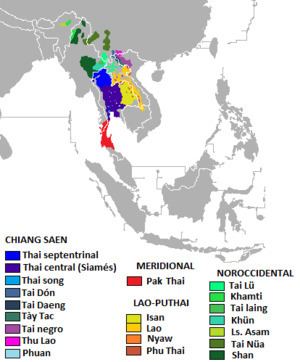Glottolog sout3184 | Proto-language Proto-Thai | |
 | ||
Linguistic classification Tai–KadaiTaiZuojiang–ThaiNung–ThaiWenma–SouthwesternSapa–ThaiThai Subdivisions Southern ThaiCentral–Eastern Thai | ||
The Southwestern Tai a.k.a. Thai languages are an established branch of the Tai languages of Southeast Asia. They include Siamese (standard Thai), Lao, and Shan in Burma.
Contents
Classification
The internal classification of the Southwestern Tai languages is still not well agreed on.
Chamberlain (1975)
Chamberlain (1975) divides Southwestern Tai into 4 branches.
Chamberlain based his classification on the following phonological patterns. (Note: For an explanation of the notation system for Tai tones, see Proto-Tai language#Tones.)
- /p/ vs. /ph/
- tone *A column split/merger pattern
- tone *BCD columns split/merger patterns
- B-DL tonal coalescence
Tai Muong Vat of Yen Chau, Vietnam is a PH-type language like Lao, even though it is geographically surrounded by Black Tai (Theraphan 2003; Chamberlain 1984).
Edmondson & Solnit (1997)
Edmondson & Solnit (1997) divide the Southwestern Tai languages into two major subgroups. According to this classification, Dehong Tai and Khamti are the first languages to have split off from the Southwestern Tai branch.
- Northern: Tai Nua = Shan-Tayok (Chinese Shan), Khamti
- Southern: Burman Shan ("Shan proper"), all other Southwestern Tai
A transition zone between the Northern and Southern groups occurs among the Tai languages (including Tai Mau) around the Burma-China border region of Mangshi, Namhkam, and Mu-se near Ruili.
This bipartite division of Southwestern Tai is argued for by Edward Robinson in his paper "Features of Proto-Nüa-Khamti" (1994). The following features set off the Nüa-Khamti group from all the other Southwestern Tai languages.
- Labialized velar stops have become velar stops.
- Tripartite split of the A tone A1-23-4
- Merger of A23 and B4
- The low vowels /ɛ/ and /ɔ/ have merged with /e/ and /o/, respectively.
- *ʔb > m
Luo (2001)
Luo Yongxian (2001) also recognizes the uniqueness of Dehong Tai (Tai Nüa), but argues for that it should be placed in a separate Northwestern Tai branch with Southwestern Tai as a sister branch. Luo claims that the Northwestern Tai branch has many Northern Tai and Central Tai features that are not found in Southwestern Tai. His proposed tree for the Tai branch is as follows.
Pittayaporn (2009)
According to Pittayaporn (2009:301), Southwestern Tai (his subgroup Q) is defined by a phonological shift of *kr- → *ʰr-.
Pittayaporn (2014) also suggests that Southwestern Tai began to disperse southward after the 7th century C.E. but before the 11th century C.E. (between 700 and 1000 C.E., during the late Tang dynasty or early Song dynasty), as evidenced by loanwords from Late Middle Chinese.
Languages
Southern Thai (Pak Thai) is often posited to be the most divergent; it seems to retain regular reflexes of early tonal developments that were obscured in the other (Central–Eastern) languages. The reconstructed language is called Proto-Thai; cf. Proto-Tai, which is the ancestor of all of the Tai languages.
The following tree follows that of Ethnologue.
According to Ethnologue, other Southwestern languages are Tai Ya (China), Pu Ko (Laos), Pa Di (China), Tai Thanh (Vietnam), Tai Long (Laos), Tai Hongjin (China), Yong (Thailand). It is not clear where they belong in the classification above. Ethnologue also lists under Tai, without further classification, Kuan (Laos), Tai Do (Viet Nam), Tai Pao (Laos), and Tay Khang (Laos). Geographically these would all appear to be Southwestern.
Ethnologue also includes Tày Sa Pa (Sapa) of Vietnam, which Pittayaporn excludes from Southwestern Tai but classifies as the most closely related language outside of that group. Pittayaporn also includes Yoy, which Ethnologue classifies as a Northern Tai language.
